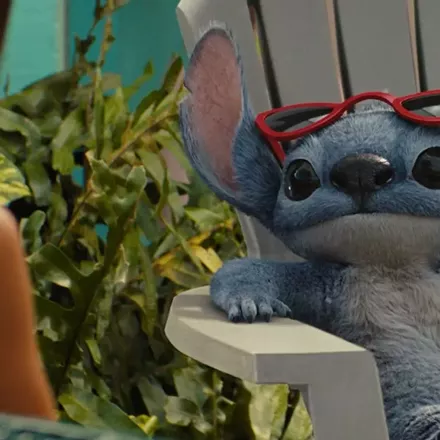Iron Man 2
Stark Contrast: Iron Man 2 leaves you wanting more of the guy who made the original fly.
By Scott Renshaw @scottrenshawFor the sake of clarity, it’s not as though a performance has never before increased the popularity of a comic-book movie. It’s just that previously, it’s always been the villain—most specifically, the bookend Joker performances by Jack Nicholson in 1989’s Batman, and Heath Ledger in 2008’s The Dark Knight. But Robert Downey Jr.’s quicksilver line readings as billionaire-turned-hero Tony Stark fueled everything that was genuinely interesting and entertaining about the first Iron Man—to the extent that, when the finale turned into a brawl between two big hunks of metal, it felt like a let-down to be deprived of Downey’s sly smirk. Tony Stark, not Iron Man, was the star.
For Iron Man 2, Favreau and screenwriter Justin Theroux attempt to hold on to what worked the first time around, while simultaneously fixing what didn’t—and that proves to be a tall order. They pick up the bulk of the action six months after the end of the first film, in which Stark announced to the world that he was in fact the armored superhero. Now out of the closet as the world’s one-man peacekeeping unit, he’s facing a variety of challenges. The government wants to appropriate Stark’s armored weaponry for national security; the arc reactor unit in Stark’s chest that keeps him alive is also poisoning him. And oh yeah, a Russian scientist named Ivan Vanko (Mickey Rourke)—the vengeance-seeking son of Stark’s dad’s ex-partner—appears to create his own dangerous variation on the Iron Man technology.
If that sounds like the all-too-common problem of trying to crank a summer sequel’s volume up to 11, you’re pretty close to right. In addition to our new villain, the filmmakers add a new Stark employee named Natalie Rushman (Scarlett Johanson) who has a few specialized skills, a weapons-manufacturing rival to Stark named Justin Hammer (Sam Rockwell) who teams up with Vanko, a beefed-up role for covert government agency boss Nick Fury (Samuel L. Jackson) and a more overtly heroic role for James “Rhodey” Rhodes (Don Cheadle, taking over the role from Terence Howard). That’s a lot of content for the narrative to absorb—plus at least a few nudging scenes referencing future planned Marvel Comics-based movies—and there’s no question that at times the whole thing starts to feel over-stuffed.
But thank heaven for Downey, who’s still a delight even when the script has his psychology bouncing in a dozen different directions: meditating on his own mortality; brooding over daddy issues; basking egomaniacally in his role as the world’s savior; etc. He’s at his best when he gets to trade do-they-or-don’t-they/will-they-or-won’t-they banter with Pepper Potts (Gwyneth Paltrow) or preen his way through his Congressional hearing, and you can feel Iron Man 2’s energy rise every time Downey is given room to have fun with his role. Every time the narrative swerves away to focus on something or someone else—even the reliably wonderful Rockwell—you can feel what’s missing.
There's not as much missing from the action sequences, however, and if Iron Man 2 ultimately feels fairly satisfying, it's because they're executed with a lot more style this time around. The racetrack confrontation between Stark and Vanko is a well-choreographed set piece, as is the final large-scale battle involving Iron Man, Rhodey's War Machine and dozens of dangerous robot drones. Even better is the showcase for Johanson as a catsuit-clad super-spy, which packs a sexy, funny wallop. When it sets out to be a bang-up action movie, Iron Man 2 delivers better than its predecessor.
But audiences didn’t fall for Iron Man because it was just another spectacle. With just a bit more streamlining, Tony Stark could have been just as compelling, and Downey’s performance even more effortlessly witty. Even as it’s delivering its entertainment, this sequel leaves you wanting more of the guy who made the original fly.
IRON MAN 2
Robert Downey Jr., Gwyneth Paltrow, Mickey Rourke
Rated PG-13
|
Scott
Renshaw:
|
Speaking of...
-
The Pipeline: Choosing Fates In Batman: The Telltale Series
If I'm going to be playing Batman's life, I prefer it to be multiple choice.
- Aug 3, 2016
-
Glad You Asked: Miranda Sings and CWMAs
- Apr 25, 2013
-
Origin of The Dark Knight Rises
Comics that formed the foundation
- Jul 31, 2012
- More »
More by Scott Renshaw
-
Film Reviews: New Releases for May 30
Karate Kid Legends, Bring Her Back, Jane Austen Wrecked My Life, Bad Shabbos, Tornado
- May 29, 2025
-
JANE AUSTEN WRECKED MY LIFE, BRING HER BACK, June 2025 Special Screenings
Two new releases, plus SLFS Summer Showdown, Wild & Scenic Festival and more.
- May 28, 2025
-
Film Reviews: New Releases for May 23
Lilo & Stitch, Mission: Impossible - The Final Reckoning, Friendship, Fountain of Youth, The Last Rodeo
- May 22, 2025
- More »
Latest in Film Reviews
Readers also liked…
-
Sundance 2025 wrap-up plus February special screenings
Uncertainty about the future location shifts focus away from the movies
- Feb 5, 2025










